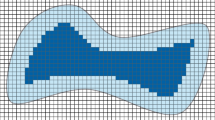Abstract
Tensor-product B-spline surfaces offer a convenient means for representing a set of bivariate data, especially if many surface evaluations are required. This is because the compact support property of the tensor-product spline allows the spline value to be obtained in a time that is (almost) independent of the number of coefficients used to define the surface. The main calculation is the precomputation involved in fitting the data and this can be impractically large if there are many spline coefficients to be calculated. Since the surface produced may be evaluated locally and efficiently, it would be advantageous to exploit local properties in order to fit the data in a piecewise manner. An algorithm to do this is presented.
Similar content being viewed by others
References
I.J. Anderson, Efficient multivariate approximation for large sets of structured data, Ph.D. thesis, University of Huddersfield, U.K. (1994).
I.J. Anderson, A piecewise approach to piecewise approximation, Technical report RR9507, School of Computing and Mathematics, University of Huddersfield, Huddersfield, U.K. (1995).
G.T. Anthony and M.G. Cox, The fitting of extremely large data sets by bivariate splines, in: Algorithms for Approximation, eds. J.C. Mason and M.G. Cox (Clarendon Press, Oxford, 1987) pp. 5–20.
Å. Björck, Numerical Methods for Least Squares Problems (SIAM, Philadelphia, 1996).
C. de Boor, On calculating with B-splines, J. Approx. Theory 6 (1972) 50–62.
C. de Boor, On local linear functionals which vanish at all B-splines but one, in: Theory of Approximation with Applications, eds. A.G. Law and B.N. Sahney (Academic Press, New York, 1976) pp. 120–145.
M.G. Cox, The least squares solution of overdetermined linear equations having band or augmented band structure, IMA J. Numer. Anal. 1 (1981) 3–22.
M.G. Cox, Direct versus iterative methods of solution for multivariate spline-fitting problems, IMA J. Numer. Anal. 2 (1982) 73–81.
M.G. Cox, Practical spline approximation, in: Notes in Mathematics 965: Topics in Numerical Analysis, ed. P.R. Turner (Springer, Berlin, 1982) pp. 79–112.
G.H. Golub and C.F. Van Loan, Matrix Computations (North Oxford Academic, Oxford, 2nd ed., 1989).
J.G. Hayes and J. Halliday, The least-squares fitting of cubic spline surfaces to general data sets, J. Inst. Math. Appl. 14 (1974) 89–103.
N.J. Higham, Accuracy and Stability of Numerical Algorithms (SIAM, Philadelphia, 1996).
NAG, NAG Numerical PVM Library Manual (Numerical Algorithms Group Limited, Oxford, U.K., 1st ed., 1995).
C.K. Pink, Parallel B-spline approximation of large sets of uniform data, Technical report RR9706, School of Computing and Mathematics, University of Huddersfield, Huddersfield, U.K. (1997).
Author information
Authors and Affiliations
Rights and permissions
About this article
Cite this article
Anderson, I. A piecewise approach to piecewise approximation. Numerical Algorithms 15, 139–152 (1997). https://doi.org/10.1023/A:1019189719519
Issue Date:
DOI: https://doi.org/10.1023/A:1019189719519




